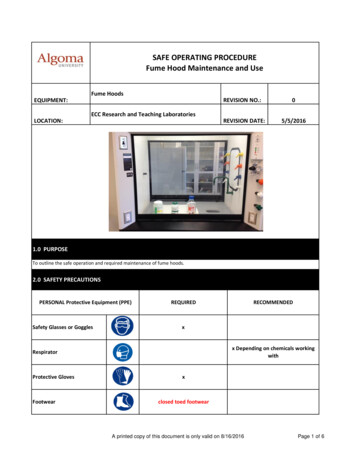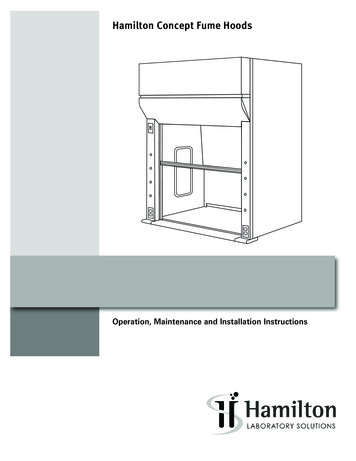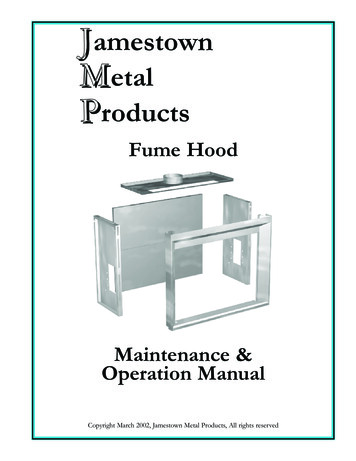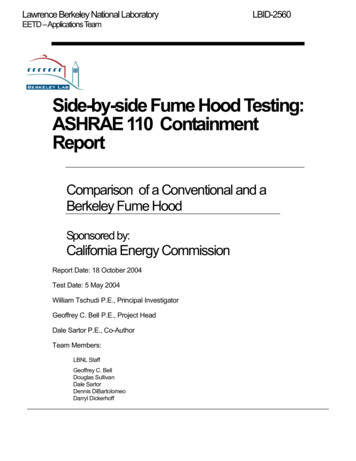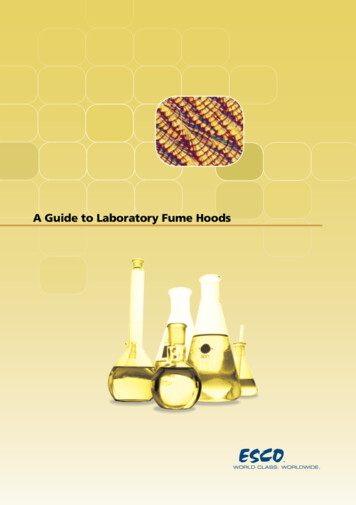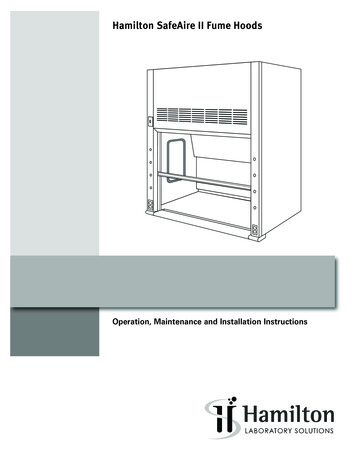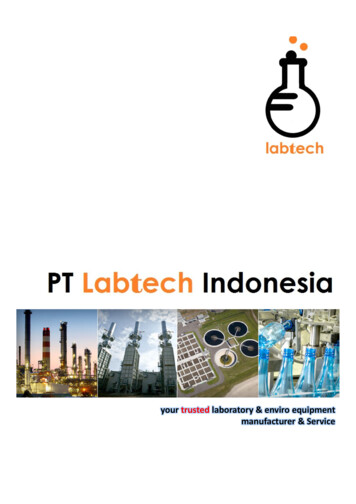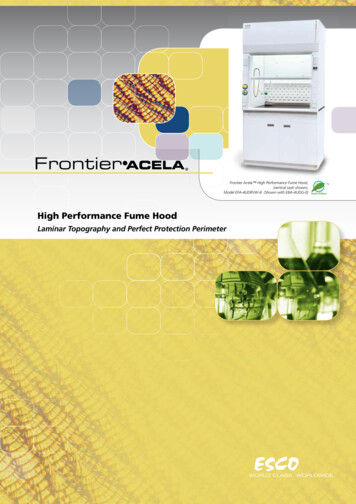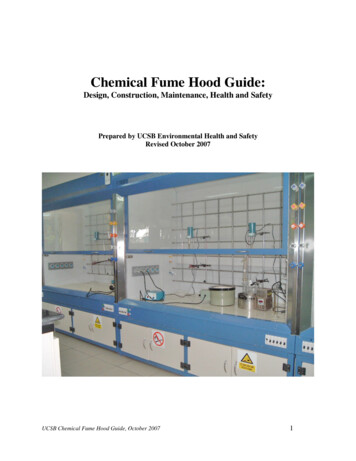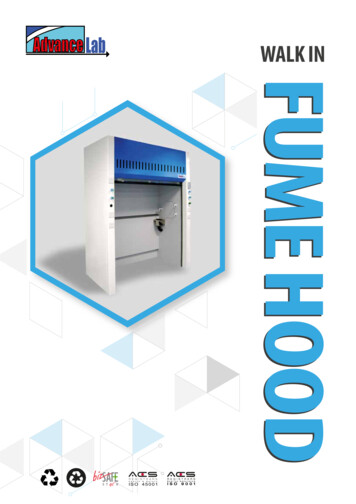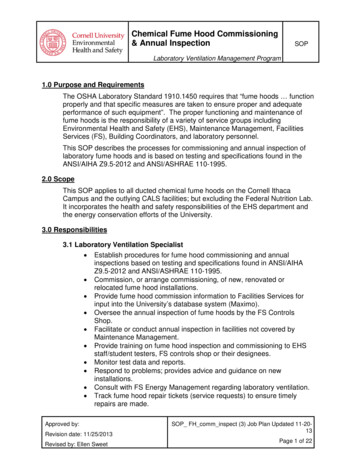
Transcription
Chemical Fume Hood Commissioning& Annual InspectionSOPLaboratory Ventilation Management Program1.0 Purpose and RequirementsThe OSHA Laboratory Standard 1910.1450 requires that “fume hoods functionproperly and that specific measures are taken to ensure proper and adequateperformance of such equipment”. The proper functioning and maintenance offume hoods is the responsibility of a variety of service groups includingEnvironmental Health and Safety (EHS), Maintenance Management, FacilitiesServices (FS), Building Coordinators, and laboratory personnel.This SOP describes the processes for commissioning and annual inspection oflaboratory fume hoods and is based on testing and specifications found in theANSI/AIHA Z9.5-2012 and ANSI/ASHRAE 110-1995.2.0 ScopeThis SOP applies to all ducted chemical fume hoods on the Cornell IthacaCampus and the outlying CALS facilities; but excluding the Federal Nutrition Lab.It incorporates the health and safety responsibilities of the EHS department andthe energy conservation efforts of the University.3.0 Responsibilities3.1 Laboratory Ventilation Specialist Establish procedures for fume hood commissioning and annualinspections based on testing and specifications found in ANSI/AIHAZ9.5-2012 and ANSI/ASHRAE 110-1995. Commission, or arrange commissioning, of new, renovated orrelocated fume hood installations. Provide fume hood commission information to Facilities Services forinput into the University’s database system (Maximo). Oversee the annual inspection of fume hoods by the FS ControlsShop. Facilitate or conduct annual inspection in facilities not covered byMaintenance Management. Provide training on fume hood inspection and commissioning to EHSstaff/student testers, FS controls shop or their designees. Monitor test data and reports. Respond to problems; provides advice and guidance on newinstallations. Consult with FS Energy Management regarding laboratory ventilation. Track fume hood repair tickets (service requests) to ensure timelyrepairs are made.Approved by:Revision date: 11/25/2013Revised by: Ellen SweetSOP FH comm inspect (3) Job Plan Updated 11-2013Page 1 of 22
Follow up on fume hoods identified by the FS Controls Shop as “TooFull to Test”.Perform quality control testing on a sub-set of hoods tested by the FSControls Shop.3.2 EHS Staff/Student Inspect fume hoods under the supervision of the Laboratory VentilationSpecialist.3.3 FS Central Zone Controls, Trades Superintendent, Zone Managers Provide FS Controls Shop Technician(s) for annual inspection andrelated. Activities, such as inspection after repairs of fume hoods, covered bymaintenance management. Oversee work done by FS Controls Shop Technicians.3.4 FS Controls Technician Schedule and conduct annual inspection of fume hoods covered bymaintenance management or those contracted with the University onuniversity properties. Schedule and conduct annual inspection of fume hoods not covered bymaintenance management when requested by the user on a fee-forservice basis. Inspect fume hoods that have out-of-date annual inspection tags within2 weeks of notification. Adjust controls during inspection if it is necessary and can be easilyaccomplished. Assign repair tickets (service requests) to hoods that fail inspection. Report hoods that are “Too Full to Test” to the Laboratory VentilationSpecialist. Enter test results into MAXIMO data base. Retest fume hoods that have been repaired. Receive annual training from the Associate Chemical Hygiene Officer.3.5 FS Central Zone Project Associate Provide Laboratory Ventilation Specialist with access to test results,including building reports and full testing reports. Send out building reports to building coordinator. Enter new fume hood commissioning data. Enter annual test results for fume hoods not covered by maintenanceManagement that have been tested by EHS.3.6 Project Manager Purchase and install hoods per FS design standard: Schedule commissioning with the Laboratory Ventilation SpecialistPage 2 of 22
Provide controls person (e.g. contractor, Control Shop Technician) toput fume hoods into unoccupied mode during commissioning of VAVand 2-position by-pass hoods.3.7 Maintenance Management, Director of Facilities Provide financial support to the controls shop for conducting annualinspection and follow-up testing of repairs for fume hoods coveredunder Maintenance Management.3.8 Building Coordinator Receive reports of annual fume hood testing. Make service requests for fume hood repairs identified outside ofannual testing cycle or by EHS. Arrange non-ticket maintenance items (e.g. new light bulb needed)4.0 Procedure Instruction4.1 TrainingFS Controls technicians, EHS students and EHS staff who perform fume hoodtesting must receive introductory training and an annual Laboratory Ventilationprogram report from the Laboratory Ventilation Specialist.4.2 Safety4.2.1 Cryogen SafetyDry ice is a cryogenic solid. Always use protective gloves and eyeprotection when handling dry ice. It is extremely cold and can burn theskin on contact. It also generates CO2 gas as it warms and in an enclosedspace can produce an oxygen deficient environment. Persons workingwith dry ice must read the SDS and be aware of the hazards beforehandling it.4.2.2 Chemical ContaminationIf there are concerns about the chemicals/equipment or contamination in ahood, do not do testing and contact the Laboratory Ventilation Specialistwith the hood ID and contact information for that laboratory.4.2.3 Guidance Documents and FormsGuidance for shop personnel doing maintenance work on hoods is givenin these documents:1. ToolBox Safety Talk Safety Precautions for Fume Hood Repair2. ToolBox Safety Talk Fume Hood Decommissioning3. Fume Hood Repair NoticePage 3 of 22
Other relevant documentation:1. Fume Hood Commissioning Request Form2. Fume Hood Decontamination Request Form3. Fume Hood Commissioning/Inventory FormFor an overview of the EHS fume hood program see the LaboratoryVentilation webpage on the EHS website:http://www.tinyurl/cornell-lvmp4.2.4 Special PrecautionsSpecial precautions are needed when testing radiation hoods.Hoods where radioactive material is used are identified withlabels or signs stating RADIOACTIVE MATERIAL on thesash or in the hood. Special procedures need to be followedwhen testing a “Rad” hood.The laboratory should be notified in advance so they can plan for the hoodtesting or schedule an appropriate time. Laboratories need to perform acontamination survey of the entire hood prior to testing and clean surfacesthat the survey identifies as being contaminated.Upon arriving at the laboratory, the tester should verify with the PI, labmanager, or hood users that a survey was done and the hood is free ofcontamination. If this cannot be verified, reschedule testing for anothertime when the laboratory can have the hood prepared. Contact EHSRadiation Safety with questions or problems.4.2.5 Iodination HoodsHoods that are used for radioactive iodination are always constantvolume, never VAV. The Radiation Section of EHS checks these hoods forradiation contamination twice a year but these procedures are notequivalent to routine annual hood testing. There are (8/26/2013) currently3 iodination hoods at Cornell:Rm 412MorrisonRm S1 091 SchurmanRm C2 221 Vet Medical Center5.0 Commissioning and InspectionCommissioning of new hoods is conducted by EHS and is arranged by ProjectManagers when required. To request commissioning, Project Managers are to fillout a Request for Commissioning Form located on the EHS LaboratoryVentilation Management webpage. For this procedure, Project Managers need toPage 4 of 22
provide a controls person to put the ventilation system into unoccupied modeduring commissioning of VAV and 2-position bypass fume hoods.Fume hood inspections are done annually and upon renovation. In facilitiesmaintained by Maintenance Management, the schedule for testing of fume hoodsis coordinated by assignment of Job Plans via the Maximo database system.Facilities not under the Maintenance Management program, but who havecontracted with the Controls Shop to perform annual testing, the scheduling offume hood inspections is accomplished in the same manner except there must bea standing service request associated with the job to allow for payment. Hoodinspectors should notify building coordinators at least 2 business days beforetesting.5.1 CommissioningCommissioning of lab ventilation systems ensures proper installation andoperation. Face velocity tests are accompanied by visual containment tests.The following procedures are based off the ANSI/ASHRAE 110 Method ofTesting Performance of Laboratory Fume Hoods and the ANSI Z9.5 Standardfor Laboratory Ventilation. The check list that EHS uses for commissioning isgiven in Appendix 5, “Fume Hood Inspection/Commissioning Form”.5.1.1 Face Velocity MeasurementThis is the measurement of the velocity of the air flow at the fume hoodsash opening, expressed in feet per minute (fpm). The procedure for facevelocity measurement is described in Appendix 2. A Shortridge electronicmicromanometer with VelGrid attachment is used to conduct the test. Thecriteria for pass/fail are described in Appendix 1, “Hood Testing Criteria”.Hoods that have an unoccupied mode (typically VAV and 2-position bypass) are tested in unoccupied mode at 18” for face velocity and captureduring commissioning. It is also verified that the occupancy sensorcontrols are over ridden when the sash is raised over 18” sash height.The project manager must provide a controls technician to put fume hoodsinto unoccupied mode during commissioning of VAV and 2-position bypass hoods.5.1.2 Dry Ice Capture TestThis is a visual test of the ability of the hood to capture vapors. Fumehood containment is determined visually and rated subjectively. Watervapor is produced by adding dry ice to warm water. ANSI/ASHRAE 1101995 provides a procedure to supplement face velocity testing with avisual test for capture called a dry ice test. We have used this procedureas the basis for our own dry ice protocol.Page 5 of 22
Dry ice can be obtained in the following laboratory containingbuildings on main campus: 1) Weill Hall basement 2) Biotech 2ndfloor 3) ST Olin basement, and 4) VRT receiving. For testing, the dry ice needs to be in small pellets or chunks. Fill a 2 liter stainless steel bowl about 3/4 full with hot water. Putsome dry ice (about ½ cup) into the bowl so that vapors are rollingout but not excessively. Place the bowl into the center of the hoodat least 6” in. If the hood is too crowded, place the bowl as close to6” back as you can. Test at the appropriate sash height(s). Observe the airflow at the face of the fume hood. The patternsacross the bench of the hood can be described as:1. If the smoke moves forward toward the front of the hood, the airflow is described as “reverse flow.”2. If the smoke remains on the work surface without smoothlyflowing to the back baffle, the air flow is described as “lazy.”3. If the smoke moves outside the plane of the sash, theobservation of such is described as /collection 2013/tpsgcpwgsc/P4-32-2013-eng.pdfThe vapor should be pulled inside and to the back. Move the bowlto the left & right. If no vapors or a trivial amount break the plane ofthe sash then the test passes. Vapors should not consistently breakthe sash plane. If there is any dry ice left in the bowl after testing, either let itdissolve or pour the left over ice into the side of a sink. Do not toleave the dry ice in the drain since it could freeze the trap and burstthe pipe.5.1.3 Room PressurizationLaboratories should be under negative pressure relative to hallways andoffices. This means that the ventilation being supplied to the lab is slightlyless than that which is being exhausted. This can be verified either with theShortridge Meter or visually using dry ice. In order to balance the energyconservation efforts of the University and the safety of laboratory workersthere is no numerical value recommended to accomplish this pressuredifferential. Follow the directions supplied in the Operational Manual for theShortridge meter. There is no quantitative minimum value expectedat this institution; only that there is a negative value. The water vapor for the dry ice test should visually draw into thelab. In many cases there are buildings connected to adjacentPage 6 of 22
Standard Procedure TitleStandard Procedure NumberChemical Fume Hood Commissioning andAnnual InspectionUnitEHSbuildings. If, during a dry ice test of the room, there is theoccasional drawing out of water vapor into the hallway, theLaboratory Ventilation Specialist must be notified. Recommissioning of the labs or entire building may need to be done.5.1.4 Visual InspectionWhen a fume hood is not actively being used, the sash of a fume hoodshould be closed. This conserves energy in a Variable Air Volume system(VAV) and maintains safety by providing a smaller opening area. Initialsash height is recorded so that both EHS and FS Energy Managementcan evaluate how consistently laboratory staff are adhering to theserecommendations.A visual inspection of the hood is done to ensure its integrity and workingorder. Cracked glass, sashes that don’t operate properly (stuck or creepdown); poor visibility and lights not working are examples of things thatwould be noted as needing repair.5.1.5 Posting and StickeringFume hoods should have various postings and stickers on them. Thetypes of postings/stickers and their placement are described in“Stickerings & Postings”, Appendix 4. Any missing items or items thatneed updating are put on at the time of the inspection. To obtain a newsupply of stickers, labels or signs, see Appendix 5, “Fume Hood TestingChecklist & Inventory”.5.2 Fume Hood Commissioning at 80 FPMStandard fume hoods designed to have increased capture capabilities andbetter fluid dynamics may be candidates for commissioning at a lower facevelocity. These hoods do not have the same pass/fail criteria and mustmaintain 80 fpm at the time of annual inspection.Candidates for commissioning and subsequent inspection must meet all ofthe following criteria or be returned to a face velocity of 100 fpm (occupied)and 65 fpm (unoccupied): Consistent and stable face velocity readings across the area beingmeasured with the VelGrid. This is to be tested with items blockingairflow inside the cabinet. Visual capture of water vapor as described above with the sash at aheight of 18” and full open; usually 2.5’.Page 7 of 22
Standard Procedure TitleStandard Procedure NumberUnitChemical Fume Hood Commissioning andAnnual InspectionEHS Commissioning and inspection with the room in unoccupied mode.The face velocity must maintain containment at 65 fpm with thesash open and at 18”. Proper hood usage must be maintained. During annual inspectionthe HHS must be 2. If this score is the result of competing usagesor contamination that is left (HHS of 4 or 5), the face velocity mustbe returned to 100 fpm.Hoods that are potential candidates for this lower face velocity are to becommissioned by the Laboratory Ventilation Specialist with the assistanceof a controls technician. Those that are successfully commissioned at 80feet per minute will be marked with a green face velocity sticker.5.3 Annual Performance InspectionThe steps for routine containment inspection are the same forcommissioning with the exception of testing in unoccupied mode. SeeHeadings 5.1.1 through 5.1.5. An addition to the visual inspection is thedocumentation of the Hood Housekeeping Score in Heading 5.4.5.4 Hood Housekeeping ScoreThis scale is based on best practices for safe and sustainable fume hooduse. Trends in these scores will be used to design laboratory workertraining and education efforts.Hood Housekeeping Score (HHS)Reason forconcern1Hood decommissionedNone2Hood on, used for a single chemical process or wellorganized multiple purposesNone3Hood on, but empty or being used for storageSustainability4Hood on, crowded or used for competing multiplechemical usesSafety5Hood on and contamination evidentSafetyThe higher the Hood Housekeeping Score, the more serious the concernPage 8 of 22
Standard Procedure TitleStandard Procedure NumberChemical Fume Hood Commissioning andAnnual InspectionUnitEHS5.2 Fume Hood HibernationAs stated in the ANSI Z9.5 Standard, fume hoods must “maintain aminimum exhaust volume to ensure that contaminants are properly dilutedand exhausted”. This exhaust requirement can increase the volume ofventilation for the laboratory room. By temporarily turning off the hood, andonly using the general exhaust, significant energy reductions can berealized.For those labs that do not use or store hazardous chemicals that must bekept inside the hood or a vented corrosive cabinet underneath; the fumehood may be a candidate for temporary shutdown.The purpose of temporarily decommissioning a fume hood is to save onenergy costs. Identifying hoods that may be candidates is done via theHood Housekeeping Score (HHS) during the annual performanceinspection, through lab inspection or ventilation assessment or by therequest of the lab occupants.To request a fume hood to be “hibernated” the following Google Form canbe ionGuidance for those completing the task of hibernating a fume hood isLocated on the Lab Ventilation page of the EHS website.http://www.tinyurl/cornell-lvmp6.0 Hood Repair or DecommissioningWhen a hood or associated hood equipment (e.g. exhaust fan, ducts, sash) arebeing worked on or repaired by the shops, laboratory personnel may be unawarethat the hood is out-of-service. A sign affixed to the front of the sash cancommunicate this information.Guidance for shop personnel on the safe completion of fume hood or exhaustsystem repair or decommissioning is given in the documents:1. ToolBox Safety Talk Safety Precautions for Fume Hood Repair2. ToolBox Safety Talk Fume Hood Decommissioning3. Fume Hood Repair NoticeAll of these documents are located on the Laboratory Ventilation webpage of theEnvironmental Health and Safety website.Hoods that have had exhaust system repair or controls adjustment should berecertified before repair signage is removed. This can be completed by thePage 9 of 22
Standard Procedure TitleStandard Procedure NumberChemical Fume Hood Commissioning andAnnual InspectionUnitEHSLaboratory Ventilation Specialist.7.0 ReportingA report should be sent to the building coordinator and Laboratory VentilationSpecialist when testing is complete. The building coordinator is responsible forissuing service requests for fume hoods or other ventilation system componentsthat need repairs or adjustment.All data is to be transferred to the Maximo database system.8.0 Quality ControlTracking the performance of the Lab Ventilation Management Program isintended to maintain the quality of service provided to the stakeholders as well asmanage the proper functioning of the mechanical systems. Information gatheredhelps staff to identify coaching and training needs.DescriptionDistribution of Labs with Lower Ventilation AssignmentsImprovements in Hood Housekeeping Scoring (HHS)Reduction of Energy Usage by Cornell Labs on an annual basisTrends in lab safety based on inspections and IAQ concernsType of IndicatorLeading SustainabilityIndicatorLeading Safety IndicatorLagging SustainabilityIndicatorLagging Safety IndicatorInformation gathered includes: Fume hood usage based on the HHS Chemical storage and segregation Awareness of safety value of lab ventilation Communication by lab occupants of possible chemical exposures Fume hood face velocity within ANSI Z9.5 parameters Effective Operations & Maintenance9.0 DefinitionsAIHA: American Industrial Hygiene AssociationANSI: American National Standards InstituteASHRAE: American Society of Heating, Refrigerating and Air-ConditioningPage 10 of 22
Standard Procedure TitleStandard Procedure NumberChemical Fume Hood Commissioning andAnnual InspectionUnitEHSEngineers10.0 ReferencesANSI Z9.5- 2012 Laboratory VentilationANSI Z10- 2012 Occupational Health and Safety Management SystemsASHRAE 110-1995 Method of Testing Performance of Laboratory Fume HoodsPage 11 of 22
Appendix 1: Hood Pass/Fail UnsatisfactorySatisfactoryStandard/Bypass 100 fpm18" ht80-120 fpm &pass dry ice test 80 fpm or 120fpm or fail dry icetest80-120 fpm & passdry ice test 80 fpm or fail dry ice test18” ht80-120 fpm &pass dry ice test 80 fpm or 120fpm or fail dry icetest80-120 fpm & passdry ice test 80 fpm or fail dry ice testvaryingControls respondwithin 2-5seconds anddisplays same asat 18”Display doesn’tstabilize within 10secondsControls respondwithin 2-5 secondsand displays sameas at 18”VAV controls slow torespond18” ht80 fpm and passdry ice capture 70 fpm and doesnot pass dry ice80 fpm and pass dryice capture 70 fpm and does notpass dry ice18” width80-120 fpm &pass dry ice test 80 fpm or 120fpm or fail dry icetest80-150 fpm & passdry ice test 80 fpm or fail dry ice test 65 fpm & passdry ice test 65 fpm or fail dryice test 65 fpm & pass dryice test 65 fpm or fail dry ice testNegative toHallwayNeutral or PositiveNegative to HallwayNeutral or PositiveVAV 100 fpmVertical*80 fpmHorizontal*Combo*Routine TestingAll typesUnsatisfactory 120 fpm 120 fpmMust meet both vertical and horizontal criteriaAllVAV and 2Postion Bypassin UnoccupiedmodeRoomPressureAll types18” ht18” widthNAPage 12 of 22
Appendix 2: Face Velocity MeasurementThe parameter for which a fume hood passes or fails a face velocity test is found inAppendix 1. The preferred readings should be about 100 fpm; except for those hoodsthat have been commissioned at 80 fpm.The VelGrid attachment should be used with the Shortridge meter for takingmeasurements at 18” sash height. Testing should be in a grid pattern divided into evensections. Readings should be taken with the VelGrid flush against the top or bottom ofthe face opening. Align the VelGrid along the plane of the sash. Hold the probe as stillas possible. Do not stand directly in front of the area being tested, as this will affect theair flow.Record the readings directly into a hand held meter. The average of all the readings istaken and then transferred into the MAXIMO data base. Readings that EHS takesduring routine testing are recorded in a spreadsheet and sent to a MAXIMOAdministrator for input into MAXIMO. For commissioning, readings are recorded on theFume Hood Inspection/Commissioning form. This information is also sent to a MAXIMOAdministrator for input into MAXIMO.VAV fume hood controls should be observed for responsiveness. Move the sash downfrom 18” stopping at different sash heights. If there is a digital control box, the facevelocity should be seen to go up for a few seconds. But, it should settle at about 100fpm.18 inches vertical sash – 4 to 8 readings depending on the hood width18”456123Page 13 of 22
18 inches horizontal sash – 4 or more readings depending on the height of the hood18”4321Test these hoods with an 18” horizontal opening. Try to make the opening toward themiddle. Take a representative sample with the VelGrid staying at 3” inches from the leftor right sides. Dry ice testing should be conducted in the middle, 6” from the plane of thesash.Note: Units with combination sashes must satisfy both horizontal and vertical testcriteria.Page 14 of 22
Appendix 3: Special “Hoods”A. Radiation HoodsSee Section 4.2.1 “Safety” of SOP Fume hood Commissioning and RoutineTesting Procedures.B. Double sash hoodsThese hoods are like two hoods side by side but with no inside wall so that the sashheight from one affects the face velocity of the other. These should be tested (facevelocity and dry ice) while both sashes are at 18”.C. Auxiliary Air hoodsAuxiliary air hoods, in addition to pulling air, also have a blower that injects air into thehood. The dynamics are not easily tested so take the usual face velocity readings andalways perform a dry ice test.D. Fixed height sash/No sashFixed position sash- Test (face velocity and dry ice) the hood at that height and usestandard/bypass criteria.No sash- Test the face velocity along the imaginary grid of the open area and do the dryice test in the working area.Hoods with fixed position sashes or no sashes should have an “Eye Protection isRequired” sticker placed on them.E. Slanting sashIf the sash is slanting, test the face velocity on the verticalplane not the slanting plane. Dry ice testing should beconducted in the middle, 6” in from the vertical plane.F. Ductless hoodsDuctless hoods as their name implies do not duct air to the outside but recirculate it tothe room. They are equipped with chemical adsorbing filters such as charcoal toremove chemical vapors. Filters must be changed according to the manufacturer’srecommendation. These hoods should have the filter change date posted prominently.EHS does not routinely test ductless hoods.Page 15 of 22
G. Vertical Sash Walk-in hoodsWalk-in hoods are large hoods and the openings can be 6 feethigh. They are used with large apparatus that requiresassembly such as distillation equipment. These hoods shouldalways be tested with visual capture (dry ice) in thefollowing way: Open the sash all the way. Prepare the dry iceand place it on the primary working surface and then slowlylower the sash until dry ice is captured. Place a red arrowlabel at this point and test the face velocity at this point as well.Note that this is the only case where we use a red arrow label.H. Clean hoodsClean hoods are found in Duffield Hall. Theyare designed to keep the work clean by runningthe majority of the air through a HEPA filter fromabove and only a portion through the face,resulting in low face velocities. They also mayhave sinks in them. They are tested using dryice capture visualization. For testing thesehoods, contact the Laboratory VentilationSpecialist.Page 16 of 22
Appendix 4: Stickering and PostingsVertical Sash Hood1HoodI34W k b hi d2(1)(2)(3)(4)Inspection Sticker- Include Hood ID, inspector, inspection date and flow rateat sash height of 18”.“Work Behind Tape for Best Practice”- Place the tape 6” back from airfoil.“Be Safe: Lower Your Sash”- (for standard/bypass hoods) or “Lower YourSash: Save Energy” (for VAV hoods), 1 1/2” x 8”, 1 1/2” x 8”. Put on eitherthe right or left side.Telltale- This is a 1” x 5” piece of green crepe paper. Attach with tape to theboom of the sash.Page 17 of 22
Combination Vertical/Horizontal Sash Hood51HoodI34W k b hi d2(1)(2)(3)(4)(5)Inspection Sticker- Include Hood ID, inspector, inspection date and flow rateat sash height of 18”.“Work Behind Tape for Best Practice”- Place the tape 6” behind the airfoil.“Be Safe: Lower Your Sash”- (for standard/bypass hoods) or “Lower YourSash: Save Energy” (for VAV hoods), 1 1/2” x 8”. Put on either on the rightor left side. Position such that the bottom of the sticker is about 1” above theairfoil (or, if no airfoil, the hood work surface)Telltale- This is a 1” x 5” piece of green crepe paper. Attach it with tape tothe boom of the sash.“Don’t Open Too Wide”- Position mid-way above sash on frame.Page 18 of 22
Horizontal Sash Hood31HoodI2(1)(2)Inspection Sticker. Position at about 18” above hood counter on frame.Includes Hood ID, inspector, inspection date and flow rate at sash width of18” (standard/bypass hood/VAV) and 12.“Work Behind Tape for Best Practice”- Place the tape 6” behind the airfoil.(3)“Don’t Open Too Wide”- Position mid-way above sash on frame.Page 19 of 22
Appendix 5: Fume Hood Testing & Inventory ChecklistSpreadsheet or Job Plan of hoods to be tested or commissionedUnassigned asset numbers for commissioning new fume hoodsMake sure control shop or contractor is available to put room in unoccupied mode(commissioning VAV and 2-position bypass only)Safety glasses and possibly a hard hat in construction zoneID/BadgeFacility code and floor plansBuilding coordinator contact infoShortridge (make sure it is charged). Other items include- inspection stickers, tapemeasure, marker, pen, inventory forms, tell-tales, tape, and other stickersDry ice kit (Billing code: P76 4705-6650)Key from Customer Service if necessaryTestingRecord initial sash heightRadioactivity: Have staff surveyMeasure velocity (vertical & horizontal)Dry ice test (vertical & horizontal)Room pressureReplace inventory stickerAdd stickers/telltaleEnter data (inspection or commission)Send report to Maximo AdministratorOrdering/Obtaining Stickers and Postings:1. Red arrow stickers and eyewear stickers. We use very few of these, so it is most efficient to printthem in the office using the color laser printer and matt white polyester adhesive Film/MWLP) or white vinyl adhesive Film/PSP-WLV8511) . The templates can be foundat G:\RESEARCH & RADIATION SAFETY\LRS\Research Safety\Hoods\Labels.2. The” inspection” stickers and the “Hood Use Double Green Arrow” sticker can be ordered from:Quadra Flex Corp1955 Route 13 NorthPO Box 286Cortland, NY 13045607-758-7066Page 20 of 22
3. The “Keep Your Sash Low – Energy Poster”, “Don’t Open Too Wide – Energy Poster”, “Be Safe:Lower Your Sash, “Lower Your Sash: Save Energy” and “Don’t Open Too Wide” can be printed andlaminated by Cornell Printing Services.4. Green Arrow sticker. To print them in the office using the color laser printer and matt white polyesteradhesive film /MWLP) or white vinyl adhesivefilm /PSP-WLV8511).5. “Work Behind Tape” rolls can be purchased from Uline: http://www.uline.com/cls 02/Tape.6. Telltales- This is green crepe paper that can be purchased at any arts supply store. Cut into 1” x 5”strips.Appendix 6: Job Pl
Establish procedures for fume hood commissioning and annual inspections based on testing and specifications found in ANSI/AIHA Z9.5-2012 and ANSI/ASHRAE 110-1995. Commission, or arrange commissioning, of new, renovated or relocated fume hood installations. Provide fume hood commission information to Facilities Services for
